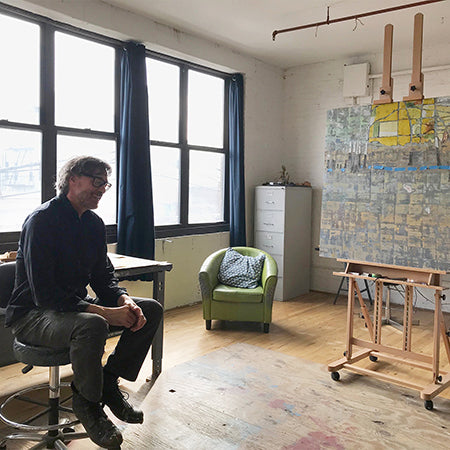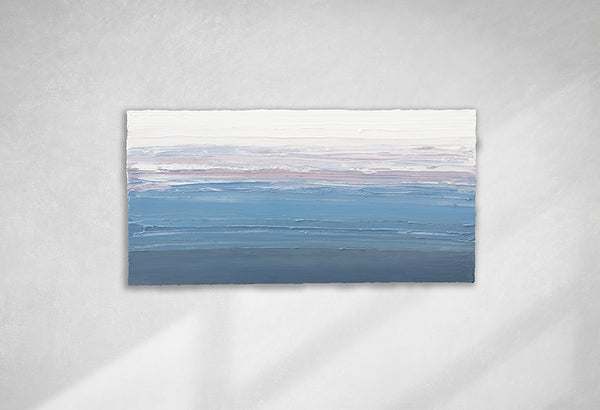Last month, we announced our plans to integrate sustainability into our business practices at Sorelle. This included everything from our existing approach to producing prints-on-demand, to new efforts of planting trees for each artwork sold and offering carbon neutral ordering. Then, a few weeks ago, you may recall that we announced our new blog series - The Conscious Creative - where we planned to talk to our artists about what they do in the studio to keep sustainability top of mind. So guess what: It's finally here! In our first Conscious Creative installment, we chatted with artist Ned Martin about his training and evolution as an artist, the necessary trial-and-error of experimenting with innovative materials, and how he sees sustainability in the context of his own operation as an artist.
Our Discussion with Ned Martin
You recently relocated your studio. Where is it located now?
We are buying a home in West Harlem so I wanted to be closer to my living space and found a beautiful studio in South Bronx. It's pretty perfect for me - high ceilings, wooden floors, exposed brick, lots of large windows. Work environment is VERY important.
That sounds beautiful, congratulations! So, before jumping straight into sustainability - tell us about your artwork and art style in general.
I started in the genre of hyperrealism, searching for texture and mood. But I was a colorist from the start, so I found a way to paint realism in an abstracted way, by scratching through brushstrokes. Then, I experienced a life-changing event: my wife died from a horrific horse accident in front of me. I ended up hiding from reality, and turned to 100% abstraction. After about four years of that approach, I began incorporating realism back into my abstracts.

Wow, you have an incredible story and artistic evolution. That combination of abstract and realistic styles is certainly evident, but we can't help but notice that in those pieces that are not purely abstract, your subject is very often different types of birds. Why do you gravitate toward birds as a subject?
Flying has always been fascinating to me. I must have been a bird in a previous life. Flying is about as free and powerful as you can get.
One sustainable practice you employ with your work is the use of recycled aluminum. How you source that?
A friend of mine owns a very large printing press. I get the used aluminum printing plates from him. Funny, but the first time I went to pick up plates they had picked out all the most pristine, like-new plates and I rejected them. “Give me the really used ones,” I said. “The ones with lots of character!”
And how do you incorporate it into your work?
I either adhere them to a panel then paint on top of them while leaving some of the plates show through, or I paint on panel and add the plates in with more of a collage technique.

Some of your paintings have wording visible - it looks like newspaper text. Where does that come from?
That’s the used printing plates showing through. I consider the art like a time capsule. You can read about a softball team who won a tournament, or see pictures of political candidates and Disney logos.
That's an interesting take - artists very often have documented the societal climate of their times, so that's a really contemporary way of subtly alluding to your cultural environment. How did it occur to you that you could use aluminum in your artwork?
I am pretty familiar with the printing process and knew they used aluminum for printing plates for large quantity runs. I love hard surfaces to paint on because I am pretty physical with paint— for example—scratching through paint and using pieces of metal as so-called brushes.
How was that process of adapting to painting on aluminum? Did it take you a long time with trial and error?
It took a lot of research and test runs. I tried all kinds of surfaces and processes, like materials from Home Depot or reclaimed materials at first. Then I thought of reclaimed printing plates and started testing them. I wanted to be certain that the paint was going to have zero problems with future yellowing, cracking, fading or peeling. In part, that is why I ended up using walnut oil as a binder and alkyd (which is a durable resin) as a medium.
What do you think the aluminum adds to a painting?
It’s hard to explain but it kind of glows because it’s reflective. And for my style of painting, the paint sits on top of the surface - zero absorption - so the painting process is sort of time sensitive and immediate. You put it down and that's where it stays.

What about your paints? Tubes of paint can be rather wasteful – how do you accommodate for that?
I grind my own paints and purchase pigments by the pound. There is absolutely no waste. I have been painting for many years. I can’t imagine all the normal size empty tubes that would have ended up in the landfills.
That would be really interesting to try and calculate! How do you mix your own paint using pigment?
It takes me about 45 minutes to grind all the hues that I use in my normal palette. I grind the paints in order as they are placed on my palette, starting with titanium white, then cadmium yellow, cadmium orange, etc. I make a small mound of dry pigment on a marble slab, put a conical hole in the top so it has a volcano shape, and add walnut oil. Then I grind the paint to a smooth, consistent paste, and transfer it to my palette.
How and where did you learn such a skill?
I went to The Schuler School of Fine Art in Baltimore. It's a school that teaches the techniques of the Old Masters. It was simply the best art instruction I ever received.

Do you find that it enhances the painting in any way, and, by extension, do you find that your mixed paint is higher quality than the tubes of paint you’ve used in the past?
Absolutely! There are fillers in store-bought paint. Even the most expensive brands often have surplus and inferior binders. I control everything that goes in to my paints, so the quality of saturation and pureness is unmatched.
On the flip side, do you find that you’re ever limited by mixing your own paint?
No, it’s actually the opposite. I have a vast array of pigments to choose from, and my paint lasts for a week on my palette. Most tube paint starts to form a skin and dry out in 24 hours.
Does sustainability play in to your creative process in any other ways?
I find it very interesting to consider what comes first- sustainability or the creative process. Does one set out using sustainable materials to make art? Or do you formulate a creative process that incorporates sustainable materials? I would like to think that the two are symbiotic, like a dance between partners. The way we live our lives, including eating or consuming energy, is governed by choices. My art process, along with the materials I use, is included in a conscious effort to reduce waste, recycle, reclaim… down to the painting rags. I even create my own painting tools from scrap metal and wood.

Taking a broader view, what is your goal as an artist?
I am not into awards, or millions of followers on social media or what most would call "fame." I do, however, work hard, and expect to earn a good living. Ultimately, I would like to be remembered as an important artist of my time in the context of art history.
Finally: What’s your favorite place on earth?
Nowhere. That is, in the middle nowhere - ideally with loved ones (which includes the dog) in nature by the water.
To see all art by Ned, including paintings and prints, visit his Artist Collection. You can also learn more about our exhibition, Fragmented in Time, on the blog, which features Ned's work on view at Sorelle through the end of October 2021.



1 comment
Post a comment
Linda Bigness
Wonderful interview. Thank you Ned for sharing your process and artistic views. Also, I love your work and the way you combine the real with the abstract. LB